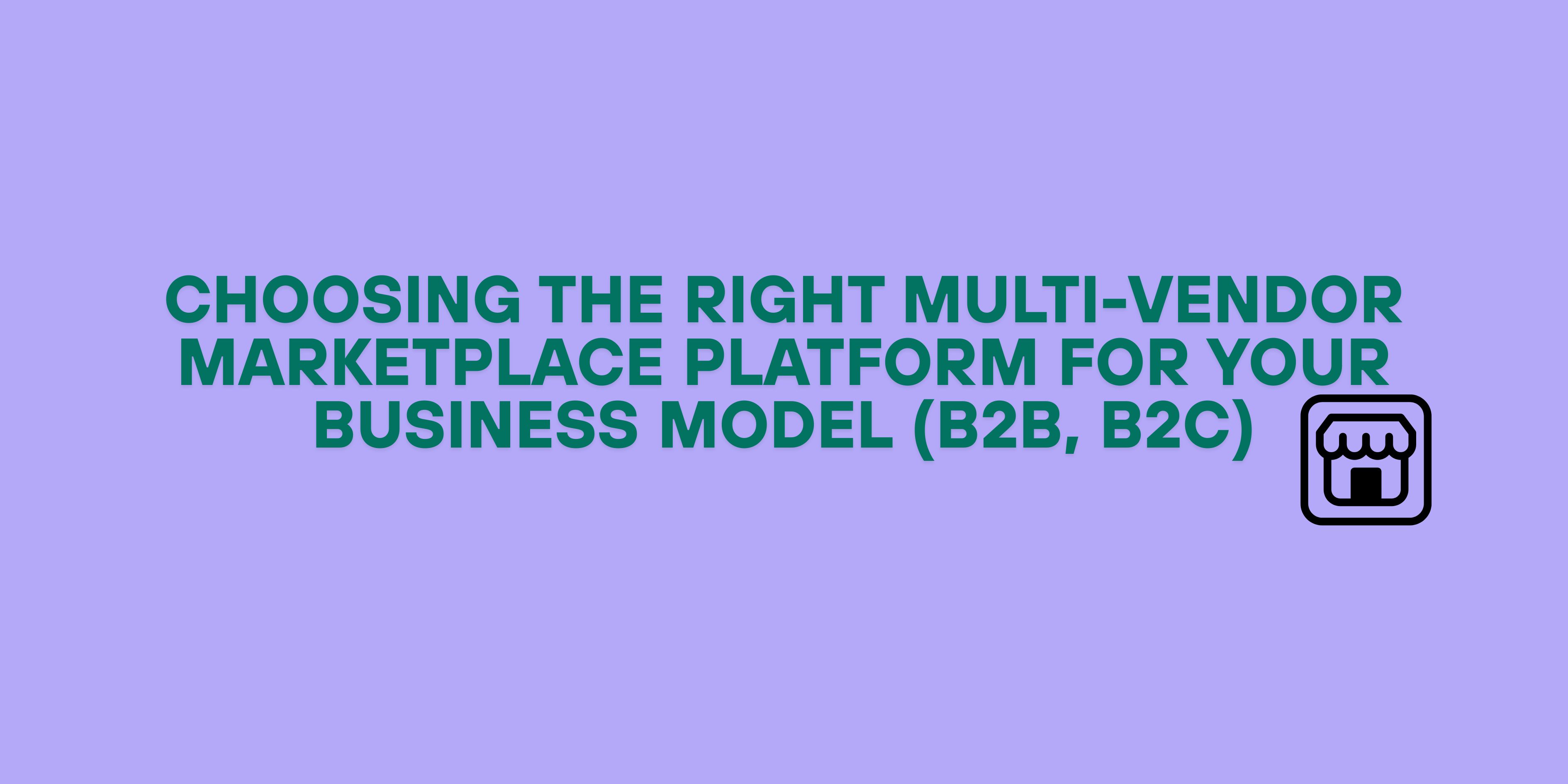Choosing the Right Multi-Vendor Marketplace Platform for Your Business Model (B2B, B2C)

Strong 8k brings an ultra-HD IPTV experience to your living room and your pocket.
Building an online marketplace where multiple sellers can list and sell their products is a smart way to create a scalable eCommerce business. But before launching, one important decision needs to be made—choosing the right multi-vendor e-commerce platform.
This choice depends largely on your business model. A platform that works well for a B2C marketplace might not meet the needs of a B2B setup, and vice versa. Each model has its own requirements in terms of features, user experience, and vendor management.
In this blog, we’ll explain what a multi-vendor eCommerce platform is, the key differences between B2B and B2C marketplaces, and the must-have features to look for. We’ll also share a curated list of top platforms to help you find the one that fits your goals—along with a useful comparison guide to explore further.
What is a Multi-Vendor E-commerce Platform?
A multi-vendor e-commerce platform is a type of online marketplace that allows multiple sellers to register and sell their products from a single storefront. The platform owner (you) manages the overall site and earns revenue through commissions, subscriptions, or listing fees.
Unlike traditional single-vendor stores, these platforms give vendors control over their own inventory, pricing, and shipping, while customers can browse a wide range of products from various sellers in one place.
Key Advantages:
- Wider product variety for buyers
- Shared operational responsibilities between admin and vendors
- Higher scalability for platform owners
- Multiple revenue channels such as commissions, ad listings, or vendor plans
Whether you’re launching a niche marketplace or a large-scale platform, starting with the right system is essential to avoid costly technical limitations down the line.
B2B vs B2C: Which Business Model Are You Building For?
Understanding your business model is the foundation of choosing the right multi-vendor e-commerce platform. B2B and B2C marketplaces may seem similar on the surface, but their backend processes, user expectations, and feature requirements differ significantly.
B2C (Business-to-Consumer)
B2C marketplaces sell directly to end-users. Platforms like Amazon, eBay, and Etsy fall into this category. These buyers are often driven by convenience, price, and user experience.
B2C Needs:
- Fast checkout
- Mobile-first design
- Customer reviews and ratings
- Promotions and discounts
- Easy search and navigation
B2C marketplaces require a visually appealing interface, smooth user journeys, and tools to drive conversions.
B2B (Business-to-Business)
B2B platforms, on the other hand, are used by wholesalers, distributors, or businesses looking to buy in bulk. Examples include Alibaba and ThomasNet.
B2B Needs:
- Request for quotations (RFQ)
- Custom pricing and bulk discounts
- MOQs (Minimum Order Quantities)
- Invoice generation
- Account-based pricing and credit terms
In a B2B setup, the sales cycle is longer, and buyers often require more detailed product information and personalized pricing options.
Must-Have Features in a Multi-Vendor E-commerce Platform
Regardless of your business model, certain features are essential to ensure your platform runs efficiently and keeps both vendors and customers satisfied.
1. Vendor Registration and Dashboard
Sellers should be able to register easily, manage their profiles, add products, view sales reports, and process orders from a single dashboard. The vendor panel should be intuitive and role-based if necessary.
2. Product Management
A solid catalog management system is key. Vendors must be able to upload products in bulk, manage inventory, add variants, and organize listings under categories and tags.
3. Commission and Revenue Management
Your platform should support multiple monetization models such as:
- Commission on each sale
- Paid membership plans for vendors
- Pay-per-listing or feature fees
Flexible revenue models will help you scale as your vendor base grows.
4. Order and Shipping Management
The platform should allow vendors to manage orders and shipping independently. Integration with popular shipping carriers or modules for custom shipping rules is a must.
5. Secure Payments
A secure and versatile payment system is essential. Platforms should offer:
- Multiple payment gateways
- Split payments between admin and vendors
- Escrow systems (especially important for B2B)
6. Reviews and Ratings
Product reviews help build trust and transparency. Both vendors and products should have a rating system to encourage quality.
7. Multilingual and Multicurrency Support
If you plan to target international buyers or sellers, your platform should support multiple languages and currencies with automatic currency conversion.
8. SEO and Marketing Tools
To grow your user base, choose a platform with built-in SEO capabilities, marketing tools (email, discounts, banners), and integrations with analytics tools like Google Analytics.
Choosing the Right Platform for B2B Marketplaces
If you're targeting wholesale buyers or enterprise clients, your marketplace platform must accommodate more complex workflows than a typical B2C setup.
Features to Look For:
- Custom pricing and bulk discounts: Buyers may need pricing based on quantity or past orders.
- RFQ and negotiation tools: Allow buyers to request custom quotes.
- Company accounts: Enable multiple users within a buyer organization to access the account.
- Credit terms and offline payment support: Support business-friendly payment methods like net-30, wire transfers, etc.
- Detailed tax management: Ensure the platform can handle various regional tax structures and invoice generation.
In short, the platform should help streamline business transactions, which are often longer and more relationship-driven than in B2C.
Choosing the Right Platform for B2C Marketplaces
B2C platforms need to deliver an excellent buying experience to retain customers and drive conversions. A laggy interface, confusing checkout, or poor search function can lead to high bounce rates.
Features to Look For:
- Mobile-first design: Most customers shop from smartphones.
- Easy navigation: Fast product search, smart filters, and intuitive menus are a must.
- Flash deals, coupons, and banners: Allow vendors to run promotions.
- Customer reviews: Help new customers build trust in sellers.
- Social media sharing and login: Users should be able to log in using Facebook, Google, etc., and share products easily.
B2C success depends heavily on user experience and marketing features. Choose a platform that balances performance with design and usability.
Best Multi-Vendor E-commerce Platforms to Choose From
There are several multi-vendor platforms available in the market today. Some are plug-ins built on top of existing CMSs, while others are purpose-built solutions designed specifically for marketplaces.
To save time and effort, we recommend exploring this curated guide:
👉 Best Multi-Vendor eCommerce Platforms in 2025
It compares top platforms across important criteria like features, customization, scalability, pricing, and vendor support—helping you find a solution aligned with your needs.
Why Yo!Kart is a Smart Choice
One standout solution from that guide is Yo!Kart—a feature-rich multi-vendor platform that supports both B2B and B2C marketplaces.
Key Benefits:
- Built specifically for multi-vendor use (not a plugin)
- One-time license fee with full ownership
- In-built RFQ module for B2B workflows
- Separate dashboards for admin and vendors
- Multilingual, multicurrency, and mobile-ready
- Multiple monetization models
- Ongoing support and free technical upgrades for the first year
Yo!Kart is designed to be flexible, scalable, and secure—ideal for entrepreneurs launching niche or large-scale marketplaces. Whether you’re aiming to build a wholesale platform or a consumer-facing site, Yo!Kart offers the tools and freedom to do both effectively.
Conclusion
Choosing the right multi-vendor e-commerce platform is one of the most important steps when starting an online marketplace. Your business model—whether B2B or B2C—should guide your platform selection. Look for features that cater to your target audience, streamline operations for vendors, and support your long-term growth.
From vendor management and payment processing to user experience and marketing tools, the right platform can help you launch faster and scale confidently.
Note: IndiBlogHub features both user-submitted and editorial content. We do not verify third-party contributions. Read our Disclaimer and Privacy Policyfor details.







